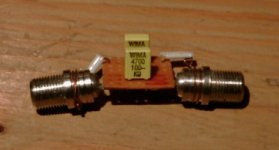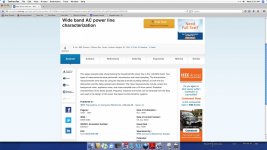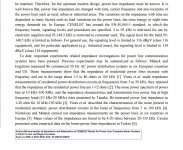Richard,
That is something I could get from Fry's? Just a cap coupler for a 75 ohm cable connection? I know the TV and the cable modem share the same drop to the house so I'll go look in the box and see if there is any isolation at all there from the incoming signal cable.
I dont know of any one selling this type of product. I make my own. A wideband video ground isolation transformer will cost at least $75.
You can make one like this --- it shows both center and shield cap coupled... but only shield needs to be cap coupled to break ground loop path. You can also get 1-3Kv ceramics which will hold off most any ground potential differences.

THx-RNMarsh
Last edited:
My local AHJ requires residential ground at three points by the building's power entrance. One rod and two pipes. Fortunately my house has new copper plumbing and old no longer used pipes so three bonds wasn't hard.
The test for a proper ground without equipment is that a connection from the hot lead to the ground should blow a 40 amp fuse. Kind of makes sense as a typical residence will usually have 20 amp fuses except for the clothes dryer and range.
As I have no cable TV or telephone lines there are no ground issues. Internet currently is wireless fed from fiber.
There are those who think the small RF fields involved can cause mental problems. Or am I missing something!
Or am I missing something!
The test for a proper ground without equipment is that a connection from the hot lead to the ground should blow a 40 amp fuse. Kind of makes sense as a typical residence will usually have 20 amp fuses except for the clothes dryer and range.
As I have no cable TV or telephone lines there are no ground issues. Internet currently is wireless fed from fiber.
There are those who think the small RF fields involved can cause mental problems.
Here in the West, California, NEW homes have water in pvc to the house and in the walls.... Even my older home has water in PVC to the house (but copper in the walls). Just single point ground rod to rebar in foundation gets it done. Most older homes have multiple grounds, so you need to make a ground isolator, as shown above #81361 to protect and to prevent noise currents thru your system.
-RM
-RM
Last edited:
Keantoken has another solution Marsh... not 100% how it works with video. To make it sound good for audio is still being determined I believe. I have yet to try the newer version of such
http://www.diyaudio.com/forums/construction-tips/251996-ground-loops-2.html#post3845378
http://www.diyaudio.com/forums/construction-tips/251996-ground-loops-2.html#post3845378
There are several commercial products to isolate the TV cable shield, installed in series with the cable of course.
An almost lossless solution comes in many power strip/ protection schemes: they have cable in and out, with the shield connected to safety earth of the Edison. Leaves the external ground loop but makes a small local ground loop that dominates. You can make one from a cable "grounding block" made for service entry and a wire to an unused Edison outlet on the strip where everything is plugged for power.
All good fortune,
Chris
An almost lossless solution comes in many power strip/ protection schemes: they have cable in and out, with the shield connected to safety earth of the Edison. Leaves the external ground loop but makes a small local ground loop that dominates. You can make one from a cable "grounding block" made for service entry and a wire to an unused Edison outlet on the strip where everything is plugged for power.
All good fortune,
Chris
Last edited:
Keantoken has another solution Marsh... not 100% how it works with video. To make it sound good for audio is still being determined I believe. I have yet to try the newer version of such
http://www.diyaudio.com/forums/construction-tips/251996-ground-loops-2.html#post3845378
I don't see a positive to the shunt resistor, just degradations. Just leave it out. The same scheme has been used in video and RF. Bosch made a 75 Ohm version for pro applications with coax wound on a large core. Not cheap. For RF a decent RF transformer works great. Jensen makes them. The secondary that feeds the TV should be tied to the local grounds on a strip or a flashover will take out your TV/cable box etc.
Here is the real source of some of the line noise- the cable is on the same poles as the power for 1000's of feet and the capacitive coupling is significant so you get current coming from the pole is effect.
All of the Monster power that have coax have a coax feedthrough that is grounded with a gas tube for the center conductor (which is virtually never needed) and tested to 2 GHz. Pretty much all the claims they get are from people who did not follow the instructions. For the millions that are in use the claim rate is very small- 10-20 per month. And less than 10 real claims (greater that $250) per year.
Monster power is still selling at a good clip, just only the plastic surge strips. As are HDMI cables. The headphones are a good example of not keeping your eye on the ball along with two outsized egos on the same room.
If they really had it together I wouldn't get any money from them. . .
The knowledgeable consultant's dilemma.If they really had it together I wouldn't get any money from them. . .
Without a resistor, there will be a sharp resonance between the total parasitic capacitance and the CMC value.I don't see a positive to the shunt resistor, just degradations. Just leave it out..
Such a high Q resonance has the potential to magnify any tiny, normally negligible effect of mode coupling, and will in fact result in large anomalies at the resonance: impedance disruptions, large CM to DM conversion, etc.
The value of the resistor might be debatable, but not its usefulness
A quick Q&A topic diversion.
Digital audio systems are serial in data transmission, and also in sampling, eg L ch sampled and encoded to serial data, then R channel sampled and encoded to serial data, then L channel sampled....ad infinitum.
Typical DA converters obey the same timings, ie the L and R channels analog outputs are serialised.
Are there audio AD converters that sample L and R coincidently before transferring the L and R data into serial data stream ?.
Are there DA convertors that output L and R analog coincidently from the serial data presented ?.
Dan.
Digital audio systems are serial in data transmission, and also in sampling, eg L ch sampled and encoded to serial data, then R channel sampled and encoded to serial data, then L channel sampled....ad infinitum.
Typical DA converters obey the same timings, ie the L and R channels analog outputs are serialised.
Are there audio AD converters that sample L and R coincidently before transferring the L and R data into serial data stream ?.
Are there DA convertors that output L and R analog coincidently from the serial data presented ?.
Dan.
If you put a wide band inductive probe next to an (DUT) equipments' ac cord and turn the equip On, you will see on a spectrum analyzer- from a quiet base line - all sorts of noise put onto the ac line.
The utility line is fairly quiet most of the time but you Always inject noise from your home equipment connected to the line. THx-RNMarsh
Richard,
I would repeat the test, but this time, use a resistive heater or a 300 watt incandescent floodlight as the switched load.
A wide band inductive probe will see the magnetic field of the cord, not the electric field. As such, lowering the impedance at the equipment end of the line cord will broadcast line hash to the probe that otherwise would not be detected.
The casual observer could come to the incorrect conclusion that it was the equipment generating the hash as opposed to it being on the line but measured due to current in the cord.
This difference means a lot with respect to where the filtering will be the most effective. If the line is the source, it is better to quash it at the wall outlet side of the system, putting a shunt filter in the equipment means the hash can couple magnetically to the grounding conductor, into the ground loop. This is distinctly different from the equipment generating the hash, so would be dealt with differently.
Jon
Keantoken has another solution Marsh... not 100% how it works with video. To make it sound good for audio is still being determined I believe. I have yet to try the newer version of such
http://www.diyaudio.com/forums/construction-tips/251996-ground-loops-2.html#post3845378
I'm guessing it wouldn't work very well for video, or you would at least have to choose a different choke due to BW limitations.
Yes. I have made those tests also with other instruments but not included here for ground loops/protection. Filtering is a whole other thing to talk about.
If people would look at the magnetic fields radiated from a speaker cable... at 3-4 feet even, the levels are surprisingly (to me) high. When you consider that speaker cables and power cables and signal I/O cables are often in close proximity at the back side of the system gear.......lots of cross-talk.
I am focused on identifying the ground loop paths, though..... CATV caused in particular. Often users had no noise/hum etc issues when they watched TV or listened to their audio systems.... until Home Theater and surround sound entered the picture..... when the two systems (which includes the CATV) get connected together, the parallel loop is created thu the gear rather than from earth to earth ground points outside.
Thus, we now have NECode requiring a single point ground at the power service entrance panel. But that doesn't help the majority of homes to date.
THx-RNMarsh
If people would look at the magnetic fields radiated from a speaker cable... at 3-4 feet even, the levels are surprisingly (to me) high. When you consider that speaker cables and power cables and signal I/O cables are often in close proximity at the back side of the system gear.......lots of cross-talk.
I am focused on identifying the ground loop paths, though..... CATV caused in particular. Often users had no noise/hum etc issues when they watched TV or listened to their audio systems.... until Home Theater and surround sound entered the picture..... when the two systems (which includes the CATV) get connected together, the parallel loop is created thu the gear rather than from earth to earth ground points outside.
Thus, we now have NECode requiring a single point ground at the power service entrance panel. But that doesn't help the majority of homes to date.
THx-RNMarsh
Last edited:
Why not?I have made those tests also but not included here for ground loops/protection.
If people would look at the magnetic fields radiated from a speaker cable... at 3-4 feet even, the levels are surprisingly (to me) high. When you consider that speaker cables and power cables and signal I/O cables are often in close proximity at the back side of the system gear.......lots of cross-talk.
Sure, but that's a different highway from the one currently being travelled in the discussion.
Which is why I asked if you did the test. You said yes, so can you post the results?I am focused on the ground loop paths, though.
THx-RNMarsh
Thanks,
John
Here is what I believe is the definitive paper on the subject of AC noise:
Thanks.
Perhaps in this century, they can look below 1Mhz for us single ended audio guys?
John
- Status
- Not open for further replies.
- Home
- Member Areas
- The Lounge
- John Curl's Blowtorch preamplifier part II

